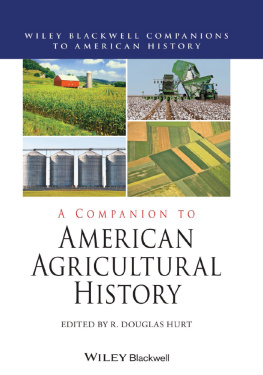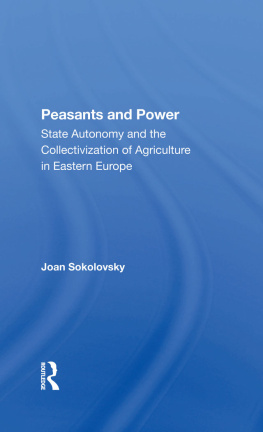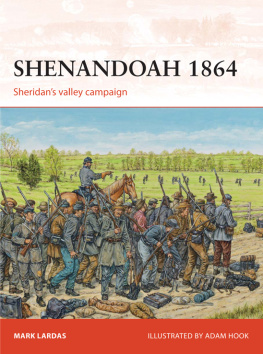Agriculture and the Confederacy
CIVIL WAR AMERICA
Peter S. Carmichael, Caroline E. Janney, and Aaron Sheehan-Dean, editors
This landmark series interprets broadly the history and culture of the Civil War era through the long nineteenth century and beyond. Drawing on diverse approaches and methods, the series publishes historical works that explore all aspects of the war, biographies of leading commanders, and tactical and campaign studies, along with select editions of primary sources. Together, these books shed new light on an era that remains central to our understanding of American and world history.
2015 The University of North Carolina Press
All rights reserved
Set in Swift Neue and Clarendon by codeMantra
Manufactured in the United States of America
The paper in this book meets the guidelines for permanence and durability of the Committee on Production Guidelines for Book Longevity of the Council on Library Resources.
The University of North Carolina Press has been a member of the Green Press Initiative since 2003.
Library of Congress Cataloging-in-Publication Data
Hurt, R. Douglas.
Agriculture and the Confederacy : policy, productivity, and power in the Civil War South / R. Douglas Hurt.
pages cm. (Civil War America)
Includes bibliographical references and index.
ISBN 978-1-4696-2000-8 (paperback : alkaline paper) ISBN 978-1-4696-2001-5 (e-book)
1. AgricultureSouthern StatesHistory19th century. 2. AgricultureEconomic aspectsSouthern StatesHistory19th century. 3. Confederate States of AmericaEconomic policy. 4. Confederate States of AmericaPolitics and government. 5. United StatesHistoryCivil War, 18611865. I. Title.
s445.h87 2015
338.10975dc23
2014030080
For Mary Ellen, Adlai, Austin, Rachel, and Erin
Contents
Maps and Tables
MAPS
1. Major Crops of the Confederate States of America, 1861
2. Cotton Production, 1859
TABLES
1. Land and Slave Valuations, by Owner, for Sandy Creek District, North Carolina, 1863
2. Agricultural Prices, Athens, Georgia, and Confederate Government, March 1, 1865
3. Tax Valuations of Slaves in Georgia, by Age, 1865
Acknowledgments
I am grateful for the assistance that I received from a number of archivists at many institutions. Dale L. Couch at the Georgia State Archives and Library, John McClure at the Virginia Historical Society, Ann Watson and Grady Howell at the Mississippi Department of Archives and History, Jim Holmberg at the Filson Historical Society, and Mattie Abraham at the Special Collections in the Mitchell Library at Mississippi State University gave generously of their time and identified important collections for my research. I am appreciative as well for the assistance that I received at the Southern Historical Collection at the University of North Carolina at Chapel Hill, Library of Virginia, Tennessee State Library and Archives, Indiana Historical Society, and Newberry Library.
Larry Mykytiuk, History Librarian, Bert Chapman, Government Information, Political Science, and Economics Librarian, Cindy Yeoman, Reference Librarian, and Dot Lanzalotto, Head of the Interlibrary Loan Office at Purdue University found elusive sources skillfully and expeditiously. In addition, David Cambron, Rachel Steely, Carla Hostetler, Richard Moss, and Richard Collins assisted my research with considerable skill and efficiency. Caroline Janney, Frank Lambert, Nancy Gabin, and Michael Morrison, my colleagues in the Department of History at Purdue University, helped answer difficult questions and suggested pertinent sources that I might otherwise have overlooked. Kayla M. Flamm at the University of Missouri prepared the crop map for the Confederate States of America. Sara Morris at the University of Kansas provided excellent leads about collections relating to agriculture during the Civil War. Nancy Cramer helped prepare the manuscript. Thanks to all.
Agriculture and the Confederacy
Introduction
On the eve of the Civil War southerners considered cotton to be king, but below the Mason-Dixon Line agriculture, primarily based on slaveryand collectively constituted from the major commercial crops of cotton, tobacco, rice, and sugarmore correctly deserved that sobriquet. Indeed, agriculture created the basis for southern prosperity. Small, diversified farms throughout the region raised a variety of crops to feed their owners families and provide enough surplus for market to enable them to purchase things both needed and desired for daily life. Across the antebellum South, these farmers practiced an increasingly commercial agriculture while meeting most of the regions food needs. The Upper South produced a surplus of wheat, tobacco, cattle, horses, mules, and hogs. Farmers in Georgia, Alabama, and Florida raised cattle for southern markets. Plantations in South Carolina and Georgia provided rice for the world, a commodity that supported a rich planter class and an extensive slave population. Cotton farmers and planters from South Carolina to Texas and north to Arkansas and western Tennessee produced most of the worlds cotton, and the staple was the leading export of the United States. Louisiana planters supplied the nation with sugar and molasses, the former a commodity that few people believed they could live without and the latter a product that served as an important food ration for slaves. Across the region southerners raised large corn crops each year, which they ground into meal for bread and fed to their hogs for fattening.
In the South most farmers and planters, the latter of whom I define as holding at least 500 acres and twenty slaves, not only believed their way of life and the institution of slavery was superior to northern farming and agricultural labor; they also contended that northerners did not appreciate and value southern contributions to the national economy. Moreover, southerners assumed that northerners would soon pay a high price for their false assumptions about the driving force of the American economy. Indeed, they knew that God smiled on the South in ways that he did not on the North, that their agriculture prospered as a result, and that it would do so forever. The North needed the South, but the soon-to-be declared Confederate States of America did not need northern agriculture to survive, an optimism that soon proved false.
This study traces the decline and fall of southern agriculture during the Civil War. Specifically, I discuss agriculture in the Confederacy as an element of power, a term that southerners used and understood in relation to agriculture, similar to military power on land and at sea. I discuss agriculture as power by tracing the most important aspects of production, transportation, labor, finance, and politics, as well as the effects of military raids, impressments, and seizures by both Confederate and Union armies, among other considerations, on farmers and planters. I also discuss Confederate agriculture in relation to the provision of food and forage to civilians and soldiers and to the wars effects on food prices. My approach is to survey agriculture in the Eastern and Western Confederacy in separate chapters on an annual basis to show progressive disintegration. Although this approach will provide the reader with a sense of the major issues and developments during each year of the war, I intentionally use some topical repetition between chapters, such as the impressment of commodities, the destruction of farms, and the growth of trade across enemy lines, as well as the increasing animosity of southern farmers toward the Confederate government. By so doing, my intent is to show the cumulative deterioration of southern agriculture, with most of the region ultimately relegated to subsistence farming. I discuss agriculture only as it relates to the war. I do not, for example, include agricultural organizations, fairs, soil improvement, plant breeding, or seed selection. Fundamentally, the history of agriculture in the Confederate states is a story about food and cotton production and government policy. What southern farmers and planters produced and what the public and soldiers did or did not eatas determined by the vagaries of the conflict, crop and animal diseases, and weathercontributed to the wars outcome.






